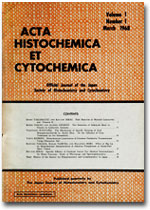All issues

Volume 3 (1970)
- Issue 4 Pages 163-
- Issue 3 Pages 81-
- Issue 2 Pages 29-
- Issue 1 Pages 1-
Volume 3, Issue 2
Displaying 1-5 of 5 articles from this issue
- |<
- <
- 1
- >
- >|
-
ARNOLD M. SELIGMAN, TAKAO KAWASHIMA, HIROMI UENO, LIONEL KATZOFF, JACO ...1970 Volume 3 Issue 2 Pages 29-40
Published: 1970
Released on J-STAGE: October 28, 2009
JOURNAL FREE ACCESSThree approaches have been investigated for the histochemical demonstration of acid and alkaline phosphatases with the substrate 2-naphthylthiolphos-phate-bisdicyclohexylamine salt, NTP. Each method results in the formation of osmiophilic end-products which are converted to osmium blacks at the sites of acid or alkaline phosphatase activity. Method A gives an osmium black via an intermediate osmiophilic diazothioether formed by capture of enzymatically liberated 2-naphthalenethiol with the diazonium salt, Fast Blue BBN. The other two methods depend upon capture of 2-naphthalenethiol with either ionic cadmium (Method B) or ionic lead (Method C) and subsequent osmication of the cadmium mercaptide or lead mercaptide.
In light microscopy, both Methods A and B give better results than Method C for acid phosphatase and especially so for alkaline phosphatase. More enzymatic inhibition of non-lysosomal acid phosphatase is noted with Methods B and C. In electron microscopy, Method A yields deposits in droplet form which are too large to relate properly to underlying ultrastructure. Methods B and C yield deposits that are too crystalline to be useful for relation to fine structure.View full abstractDownload PDF (7481K) -
AN ELECTRON MICROSCOPIC STUDYTSUGIO AMEMIYA1970 Volume 3 Issue 2 Pages 41-51
Published: 1970
Released on J-STAGE: October 28, 2009
JOURNAL FREE ACCESSPolysaccharide synthesized from glucose-1-phosphate in the nuclei of various cells in the normal rat retina was studied by electron microscope and the polysaccharide synthesizing method of Takeuchi and his co-workers.
Synthesized polysaccharide was found only in the nucleus of Müller's cells, and not in the nuclei of any other cells, such as receptor, bipolar, horizontal, amacrine cells or astrocytes.
Newly formed polysaccharide particles were located in the karyolymph of Müller's cells and had no relation to the nucleoli, chromatin or nuclear membrane. These particles appeared as fine granular form, about 700Å in diameter which were composed of subunits about 160Å in diameter and seemed to be less stainable with lead citrate than native glycogen.
There was no evidence that synthesized polysaccharide in the nucleus was removed from the cytoplasm. The present study indicates that the nuclei of some cells have the capacity for polysaccharide synthesis.View full abstractDownload PDF (11825K) -
MASANORI UONO, MASAYA SEGAWA1970 Volume 3 Issue 2 Pages 52-64
Published: 1970
Released on J-STAGE: October 28, 2009
JOURNAL FREE ACCESSMorphological and histochemical difference and feature of each type of progressive muscular dystrophy (PMD) of 84 cases were stated. Especially interesting observations were obtained in the progress of lesion of skeletal muscle and in the comparison between Duchenne type and congenital type.
In PMD, lesion of pale muscle precedes and, as the course of the disease progresses, it becomes accompanied by lesion of red muscle. The size of muscle fiber and the strength of PhR activity do not always show abreast change. In limb-girdle type, some case shows singular observation in distribution of PhR and SDH activity.
In benign Duchenne type, carrier of Duchenne type, and ocular PMD, degree of morphological change and lesion in distribution of enzyme activity is low.
In congenital PMD, histological feature similar to the muscle of 6 to 8 months old fetus is observed. Morphological changes of not only muscle fiber but also motor endplate are pretty characteristic.
Regeneration of muscle fiber can be observed most in benign Duchenne type and ocular type.
A few more discussions were made on the feature of boule musculaire and extraocular muscle in addition to the pathohistochemical observations stated above.View full abstractDownload PDF (11809K) -
RYUEI MAEDA, KOKICHI KANAZAWA, EMYO NAKANO, TADASHI KONDO, TOSHIKO YAM ...1970 Volume 3 Issue 2 Pages 65-73
Published: 1970
Released on J-STAGE: October 28, 2009
JOURNAL FREE ACCESSOn reinvestigating the specificity of the Chlorazol fast pink staining method for PVP, it was newly found that not only PVP, but also eosinophile granules in the eosinophile segmented nuclear leucocytes, eosinophile mononuclear cells, and eosinophile myelocytes as well as plasma-like substances deposited in tissues were brightly stained with this method but that no other structures did.
In this paper, the entity of the substance responsible for the Chlorazol fast pink stain-positive reaction is discussed.View full abstractDownload PDF (12347K) -
SHIN-ICHI SHIINA, VINCI MIZUHIRA1970 Volume 3 Issue 2 Pages 74-79
Published: 1970
Released on J-STAGE: October 28, 2009
JOURNAL FREE ACCESSIn the skeletal muscle, the subcellular distribution of sodium and potassium ions was similar to that in the cardiac muscle, using the histochemical technique.
The precipitates from the sodium ion were observed mainly in the intercellular space, on the I band of the myofibrillar region and inside the terminal cisternae and nucleus. The precipitates were also observed scatteringly in the mitochondria and the A band of the myofibrillar region. No precipitate was observed inside the transverse tubule.
The precipitates from the potassium ion were found on the intracellular side of the sarcolemma and of the transverse tubule. It was also observed scatteringly in the mitochondria and on the myofibrils.View full abstractDownload PDF (7487K)
- |<
- <
- 1
- >
- >|